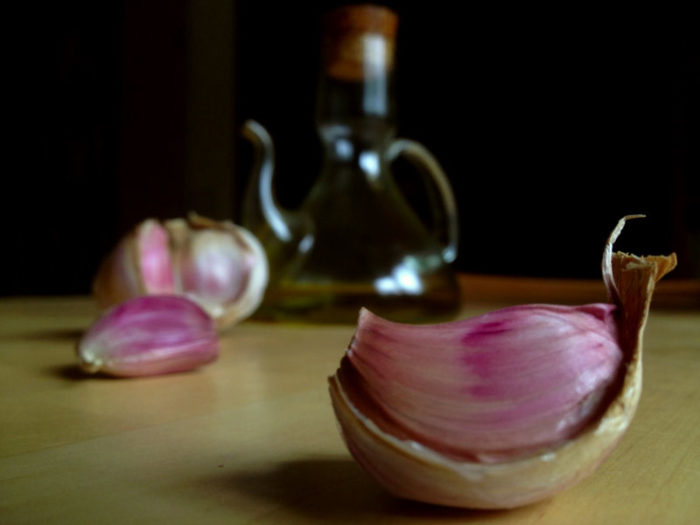The first time I came across allioli was probably back in the late 1980s when visiting l’Escala for Christmas. I don’t remember the exact circumstance, but we ended up eating lunch in a small restaurant where we were well looked after by a Catalan family and while I remember almost nothing about what we ate on that occasion, although it is likely to have been lamb, I do remember the pungent garlicky flavour of the allioli with which it was served.

Garlic and olive oil. Photo by David Leigh.
This was my first introduction to anything quite so pungent and despite having enjoyed the spicy heat of curry for years I had never had something quite so overwhelmingly garlicky.
After I started to visit Barcelona frequently in the late 90s, enjoying lamb cutlets served with allili as part of the calçotada, I ordered a copy of Catalan Cuisine by Coleman Andrews from Amazon and flipping through its pages came across a recipe for allioli.
Making it is quite straightforward; in its purest form allioli is simply an emulsion of just garlic, salt and olive oil, although many restaurants make it with egg to help bind the ingredients better.
In this form it is more like Provencal aioli, a garlicky mayonnaise, and while it is still powerful it still lacks the full on garlic power of the simpler version. I can imagine that making for restaurants it is far easier to make in bulk with egg as the garlic, salt and oil version can easily split, but one of the things that attracts me to the pure version is its simplicity.

Love it or hate it, garlic gives allioli its pungency. Photo by David Leigh.
How to make allioli
To make it you need to pound several cloves of raw garlic with a mortar and pestle and add salt to form a paste – try 6-8 cloves to a teaspoon of salt.
When the garlic and salt is quite thick start adding the olive oil, drop by drop. It turns into a surprisingly creamy emulsion, although if you add too much oil it will start to separate; the result made this way tends to be greenish thanks to the olive oil, while when made with egg is far more yellow.
If the emulsion does start to separate slightly don’t worry too much; this is known as “drunk allioli” in Catalonia.
It is really powerful and so be warned; the smallest amount of it may earn you a night or two on the sofa, especially if your other half hasn’t eaten it.
Alloli is often served with lamb, but it can also be served with fiduea and fish such as monkfish.
Interested in learning more about Catalan cookery?

If you’re interested in learning more about Catalan cookery then make sure you check out ‘Catalan Cuisine’ by Coleman Andrews. It’s packed full of authentic recipes compiled when visiting the kitchens of many of the region’s chefs.
Available from Amazon.com and Amazon.co.uk

